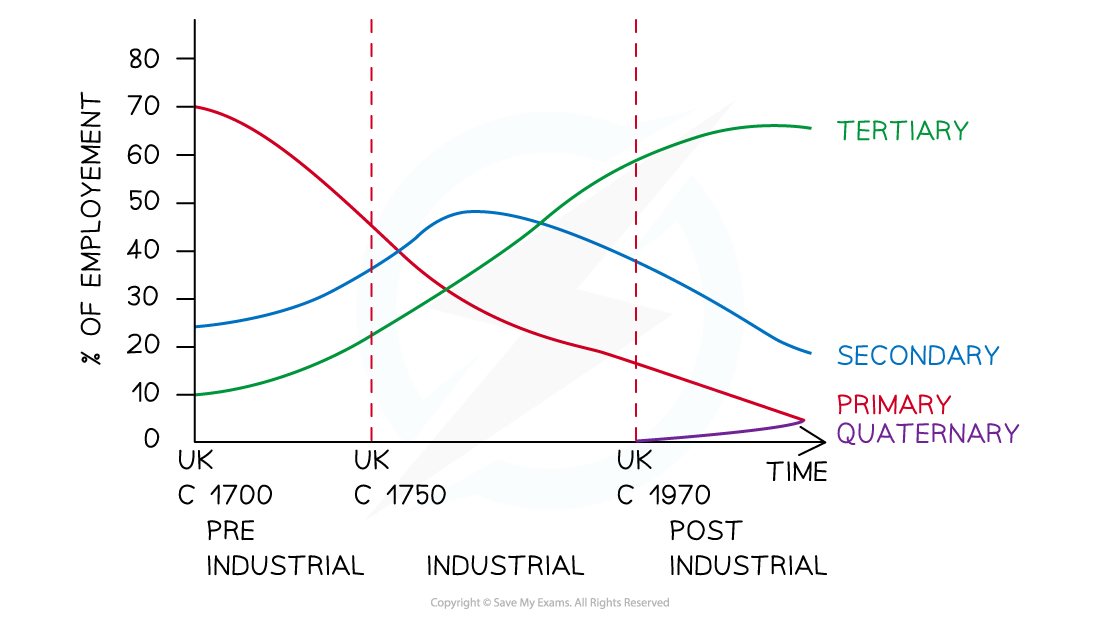Economic Changes
- The UK has been in a post-industrial stage since the 1970s and was the first country to experience the Industrial Revolution
- A country's industrial structure is the percentage of people performing economic activities
- An economic activity is the producing, buying or selling of goods and services
- Economic activities can be grouped into four sectors:
- Primary: mining, fishing, farming etc.
- Secondary: factory workers, clothing, steel production etc.
- Tertiary: nurses, lawyers, teachers, shop assistants, chefs
- Quaternary: hi-tech scientists, research and development
UK employment sectors 2020

% Employment in Economic Sectors 2020 - UK
Exam Tip
Remember the economic sectors can also be used to group employment types. For example, a farmer is employed in the primary sector whereas a teacher is employed in the tertiary sector.
- The UK’s economy has changed over time and place. The most significant changes came during the industrial revolution between 1750-1900
- The changes can be divided into 3 stages:
- Pre-industrial stage: most people worked in the primary sector such as farming or mining
- Industrial stage: more people moved into the secondary sector of manufacturing
- Post-industrial stage: emphasis is on service-based tertiary sector and quaternary sectors of research and ICT
Clarke-Fisher model

Clarke-Fisher-model showing UK economic change over time
Reading the model
- In the pre-industrial era, the majority (70%) of people were employed within the primary industry and lived in rural areas
- By the 1850s jobs in primary economic activities were rapidly declining reaching 15% in 1900
- In 1900 most people (over 60%) worked in secondary economic activities with tertiary economic activities steadily increasing
- By the 1950s tertiary economic activities overtook secondary economic activities as the main employment sector
- From the 1970s onwards there has been a steady rise in the quaternary sector of research and development (R&D) in the UK
- By the turn of the century, over 70% of people in the UK were employed in tertiary economic activities
Cause of economic change in the UK
- There are 3 main causes of economic change in the UK:
- De-industrialisation saw the decline in the UK's traditional manufacturing industries and growth in the tertiary and quaternary sectors due to:
- Global shift of manufacturing to developing countries where labour costs are cheaper, longer working hours and trade unions have no influence
- Mechanisation reduced production costs and the need for manual labour
- Globalisation and increased world trade with cheaper imported goods; contributed further to a decline in manufacturing
- Markets have become deregulated and companies have to find ways to make a profit through change and innovation
- The service sector has grown and wages increased
- Taxes are kept low, giving people more disposable incomes; mortgages become easier to obtain and house prices increase
- De-industrialisation saw the decline in the UK's traditional manufacturing industries and growth in the tertiary and quaternary sectors due to:
-
- Government policy changes:
- 1945 -1979 state-run industries were created after WWII to boost the economy, with the government supporting many unprofitable industries
- In 1973 the UK joined the European Union (called the 'common market' at that time)
- 1979 - 2010 with political change came privatisation and many of the state: run businesses were either sold or closed down and this is when UK jobs first began to go overseas
- 2010 - 2016 a ‘rebalancing’ of the economy through austerity measures, inward investments and improvements to infrastructure
- 2016 onwards -
Brexit, although it is unknown at present what the full impact of the UK's decision to pull out of the EU will be
- Changes at work
- Not only has there been a shift from primary to tertiary work but also:
- Increase in female workers
- Paid holidays and maximum working hours
- Guaranteed holidays and time off
- Working hours reduced from 48 hours a week to 40 hours or less
- Increased self-employment opportunities
- Flexible working patterns:
- Part-time work and career breaks to fit in family responsibilities or other jogs
- Paternity leave
- Flexi-time: start and finish earlier or later
- Job sharing between two or three people
- Sub-contracting
- Homeworking
- Not only has there been a shift from primary to tertiary work but also:
- Government policy changes:
Worked example
Explain one reason for the growth tertiary employment in the UK
(2 marks)
Answer:
- Increase in some sectors e.g. finance and business services (1) because of UK’s/London’s global role (1)
- Rise in incomes/borrowing (1) driving higher consumption so more employment in retail/leisure etc (1)
- Population growing (1) therefore need for services such as Drs/teachers (1)
- Uneducated/low level skills they have to find tertiary jobs (1) need to specify type of tertiary job, e.g. serving in McDonalds (1)
- As become more educated/higher education (1), therefore more suited to skilled jobs such as in financial, legal sector etc. (1)
- Deindustrialisation or decline in primary employment (1) so (statistical) increase in growth of tertiary sectors (1)


